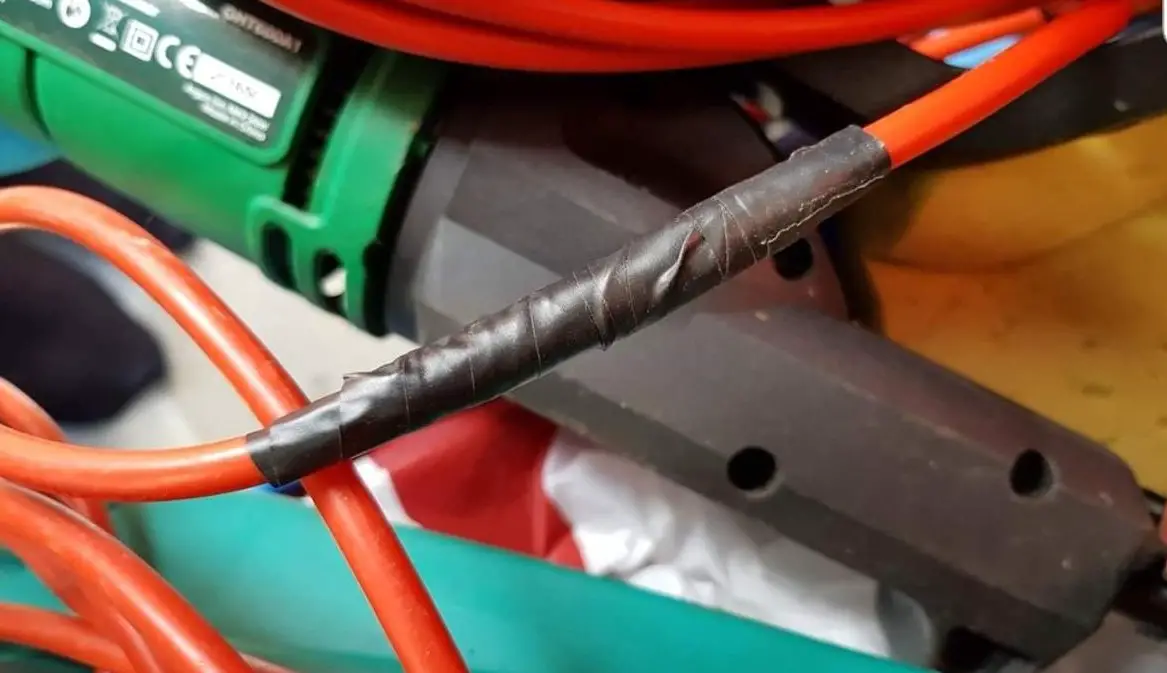When it’s time to tame the jungle that we refer to as ‘the garden’, millions of us dig out the hedge trimmer from the shed or garage and get cracking.
But how many of us give a thought to safety? After all, this is a pretty dangerous piece of equipment. Not least because they have a power cord with 230 to 240 volts running through it.
If you’re not careful, there’s a real chance that you’ll cut through the power cable, risking an electric shock.
While all good models are double insulated, it’s impossible to completely rule out the possibility of getting a shock if you accidentally cut the cord.
So, how do you avoid this?
Here are a few tips to guide you!
Hold The Hedge Trimmer Properly
Like most large power tools, hedge trimmers are designed to be used using both hands. This is to ensure that you have full control over the tool at all times.
However strong you think you are, it’s neither wise nor clever to use this machine using only one hand, especially when stretching out to trim an area that’s almost beyond reach.
This is particularly important when standing on a stool or ladder, as you risk falling, as well as possibly slicing through the power cable.
Always ensure that your feet are placed firmly and that you have both hands on the hedge trimmer.
Keep The Power Cord Behind You
Play the cable out behind you, ideally over your shoulder. Adjust the cable accordingly as you work, always moving away from it so that it remains at your back as you walk forwards.
Working towards it (especially if you are walking backwards!) will drastically increase your chances of hitting it at some point.
Some gardeners use a carabiner (a spring-loaded clip used by mountain climbers to secure ropes) attached to their belt loop on the back of their trousers. They then push the cable into this, ensuring that it stays at their back at all times.
Whether you do this or not, it’s good to stop and check where the cable is every few minutes, as it’s easy to become engrossed in the trimming work and lose track of its position.
Keep An Eye On The Extension Lead
It’s probable that you’ll be using an extension cord to reach the hedges you’re trimming, especially if your garden is longer than average.
These should always be extended to their full length*, meaning that they may get in your way if you’re not aware of them. Always allow hedge trimmers to a complete stop before putting them down, and avoid placing them on top of any cords as the blades are very sharp and may cut through them even when they are not moving.
*Electric cables that are wound up while in use can overheat! The build-up of electrical resistance can’t escape, so the wire heats up and may cause fire or electric shock.
Keep The Working Area Tidy
If your hedges and bushes are very overgrown, there may be a fair amount of garden waste sitting around as you work your way through.
It’s worth taking a break every once in a while to clear this away, rather than leaving it all until you finish the job. There is a chance that it’s covering other tools and equipment, and maybe even the cable itself, or an extension cord.
As you move along the hedge, you may stumble over these obstacles, or the cord may tangle in the twigs and leaves. It’s not unknown for people to place a hedge trimmer on top of debris rather than on the ground. And if the machine is still running, it might just cut into the cord that’s caught up in the cut bushes.
Use A Sturdy Ladder
It’s never advisable to lift the hedge trimmer above head height. Instead, where hedges are too high for you to reach safely, use a good step ladder designed for the garden, or a sturdy step-stool.
Most ladders aren’t suitable for this task, as the legs sink into the ground and make them unstable. Something with a wide base is better, like a hedge-trimming ladder, also known as a tripod ladder or fruit-picking ladder.
This gives you more stability, allowing you to focus on the job at hand and keep track of where the cable is at all times.
Keep Distractions To A Minimum
Hedge trimmers are useful pieces of equipment, but there are many potential hazards to consider.
As with all power tools, they require your full focus and attention while using them. As you sweep the trimmer blade across the hedge, you may be distracted by something.
The next thing you know, you’ve sliced through the wire.
To protect you as far as practically possible, it’s best to limit any distractions while you undertake this job. Ear defenders aren’t absolutely necessary as these tools aren’t anywhere near as loud as petrol-driven hedge trimmers. However, you may be tempted to use headphones to listen to music, podcasts, radio etc.
This is a bad idea. Chances are, you’ll become engrossed in what you’re listening to and not pay attention to the task at hand. It’s essential that you are focussed on what you are doing, or you may cut through the cable.
It’s also good to listen out for any potential problems; if your trimmer is making any odd noises it could be a sign that something is wrong.
What Happens If You Cut Through The Cable?
As mentioned at the start, it’s unlikely that you’ll be electrocuted. It’s also unlikely that you’ll even get an electric shock because most power tools are double insulated.
This means that the hedge trimmer does not have an earth wire and has a plastic case that provides insulation, ensuring that the live wires, motor, and metal parts of the machine never come into contact with the casing and cause an electric shock.
However, the possibility should never be ruled out. Around one-third of all gardeners in the UK have had an accident involving electricity at some point, and most of these are due to cutting through lawn mower or hedge trimmer power cords.
Much depends on the exact nature of the incident. That is, did you cut through the wire completely, or did you nick the cable, cutting one of the wires inside?
In the first scenario, the hedge trimmer will probably stop instantaneously because your MCB (miniature circuit breaker, also called a trip switch) will be activated because there’s a direct short circuit between the live and neutral. For those who aren’t aware, fuse boxes (or consumer units) in most houses in the UK are designed to break the electrical circuit in the event of a power surge, as you’d get when cutting through live electric wires.
In some instances, the fuse connected with that particular circuit (or ring) will blow and will need to be replaced.
Alternatively, if you catch the cable and manage to slice through a single wire, breaking either the live or neutral, the hedge trimmer will simply cut out, as the electrical circuit will be incomplete.
Reducing The Risk
While it’s not inevitable that you’ll cut through the electrical cable while using your hedge trimmer, it’s a very real possibility.
To lower the risk of receiving an electric shock, ensure that you fit a residual current device (RCD). You can plug these into a socket each time you use hedge trimmers or any other electrical equipment, and these will disconnect the electric supply within 24 to 40 milliseconds.
This is quick enough to save you from a fatal electric shock. The main cause of death in these circumstances is ventricular fibrillation, where the lower chambers of the heart essentially become useless and stop pumping blood around the body.
An RCD detects that there is a flow of electricity through the user and cuts off the supply before any damage is done. Sadly, few people seem to be aware of these life-saving gadgets, and even those who know that they exist still neglect to use them.
Can You Fix A Hedge Trimmer After Cutting Through The Cable?
It’s possible, but it isn’t always advisable unless you know exactly what you’re doing.
Many fatal electric shocks are the result of well-meaning DIY enthusiasts getting it tragically wrong.
The best advice is to take your equipment to an electrical repair specialist, someone who is qualified to fix it safely. Obviously, this costs more money, which is why people like to do the job themselves.
If you decide to do this, the first thing to do is to examine the damage – after removing the plug and making sure the hedge trimmer is switched off.
If the damage is superficial, perhaps a slight cut to the outer insulation, this can be fixed using electrical tape.
If the damage is more severe, with the cable cut through completely, it will be necessary to strip the wires and use a connector, like a terminal block, to join the two halves. Electrical tape alone will not suffice and could be a hazard.
Always make sure the male end is attached to the cord attached to the hedge trimmer, and the female end is connected with the cable attached to the plug.
If you connect the female end to the hedge trimmer and the male end to the plug, there’s a chance that you’ll touch the live connectors after plugging it in and switching it on.
Some people simply splice the wires together (sometimes using solder) before wrapping in masses of electrical tape. This is not wholly advisable but is understandable as it keeps the cost down. Even so, it should ideally be a temporary solution before getting a more permanent fix.
It is essential to make sure that each wire is connected correctly to avoid tripping the fuse box and potentially getting a shock. Your tool should have modern wiring as the UK moved onto the EU system in 2006. Double insulated items shouldn’t have a protective earth (or ground) wire, but if present, this will be green and yellow.
The neutral wire is blue and the live wire is brown. Always attach these colours correctly.
In the old wiring system, the earth wire was green, black was neutral, and red was live.
Protect Yourself At All Times
Hedge trimmers are generally safe to use, if you follow a few rules. Basically, it’s common sense!
Keep your safety (and that of your loved ones and pets) in mind at all times while trimming your hedges. This should start from the moment you plug it in until you unplug it when the work is done.
Watch out for any hazards, and keep a close eye on the cable position throughout the procedure. Attach an RCD every time and don’t raise the tool above shoulder height as you may lose your balance.
Gardening isn’t something that everyone enjoys, though millions of us do.
Whatever your feelings towards it, nobody wants it to end in injury, or even tragedy. Stay alert, check your working area, and


